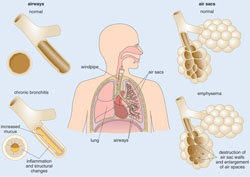4.2.2 Emphysema and chronic bronchitis
The symptoms we have just described are known as chronic bronchitis (‘bronk-eye-tuss’). Because the airways are constantly irritated and inflamed, the lining of the bronchioles becomes thicker and the space in the middle of the tube becomes smaller (see the bottom left diagram in Figure 4.3). This further restricts the amount of air that can get into and out of the lungs.
People with COPD also develop a condition called emphysema (‘em-fee-see-mah’). Persistent coughing stretches these delicate structures so much that over time they lose their elastic quality and become stiff. This means that they don’t expand as easily to let air enter. Also, the walls between many of the alveoli are destroyed by the high pressure inside the air sacs when a cough fails to dislodge a mucus obstruction. This damage leads to fewer larger air sacs instead of many tiny ones (see the bottom right diagram in Figure 4.3). If this happens, the amount of gas exchange in the lungs is reduced.
4.2.1 The lungs in COPD

